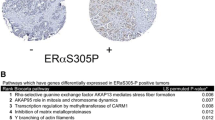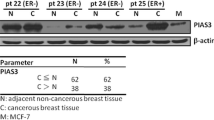Abstract
Purpose
The overexpression of mitotic kinase monopolar spindle 1 (Mps1) has been identified in many tumor types, and targeting Mps1 for tumor therapy has shown great promise in multiple preclinical cancer models. However, the role played by Mps1 in tamoxifen (TAM) resistance in breast cancer has never been reported.
Methods
The sensitivity of breast cancer cells to tamoxifen was analysed in colony formation assays and wound healing assays. Enhanced transactivational activity of estrogen receptor α (ERα) led by Mps1 overexpression was determined by luciferase assays. The interaction between Mps1 and ERα was verified by co-immunoprecipitation and proximity ligation assay. Phosphorylation of ERα by Mps1 was detected by in vitro kinase assay and such phosphorylation process in vivo was proven by co-immunoprecipitation. The potential phosphorylation site(s) of ERα were analyzed by mass spectrometry.
Results
Mps1 determines the sensitivity of breast cancer cells to tamoxifen treatment. Mps1 overexpression rendered breast cancer cells more resistant to tamoxifen, while an Mps1 inhibitor or siMps1 oligos enabled cancer cells to overcome tamoxifen resistance. Mechanistically, Mps1 interacted with estrogen receptor α and stimulated its transactivational activity in a kinase activity-dependent manner. Mps1 was critical for ERα phosphorylation at Thr224 amino acid site. Importantly, Mps1 failed to enhance the transactivational activity of the ERα-T224A mutant.
Conclusion
Mps1 contributes to tamoxifen resistance in breast cancer and is a potential therapeutic that can overcome tamoxifen resistance in breast cancer.





Similar content being viewed by others
Data availability
The data in this manuscript were generated from original work, and all raw data files can be made available upon request.
Code availability
Not applicable.
References
Tecalco-Cruz AC, Perez-Alvarado IA, Ramirez-Jarquin JO, Rocha-Zavaleta L (2017) Nucleo-cytoplasmic transport of estrogen receptor alpha in breast cancer cells. Cell Signal 34:121–132
S L-T, R S. The dynamics of estrogen receptor status in breast cancer: re-shaping the paradigm. Clinical Cancer Research. 2007; 13: 6921–6925.
Maehara K, Hida T, Abe Y, Koga A, Ota K, Kutoh E (2003) Functional interference between estrogen-related receptor alpha and peroxisome proliferator-activated receptor alpha/9-cis-retinoic acid receptor alpha heterodimer complex in the nuclear receptor response element-1 of the medium chain acyl-coenzyme A dehydrogenase gene. J Mol Endocrinol 31:47–60
Klinge CM (2001) Estrogen receptor interaction with estrogen response elements. Nucleic Acids Res 29:2905–2919
Spears M, Bartlettt J (2009) The potential role of estrogen receptors and the SRC family as targets for the treatment of breast cancer. Expert Opin Ther Targets 13:665–674
Dhingra K (2001) Selective estrogen receptor modulation: the search for an ideal hormonal therapy for breast cancer. Cancer Invest 19:649–659
Salazar MD, Ratnam M, Patki M, Kisovic I, Trumbly R, Iman M et al (2011) During hormone depletion or tamoxifen treatment of breast cancer cells the estrogen receptor apoprotein supports cell cycling through the retinoic acid receptor alpha1 apoprotein. Breast Cancer Res 13:R18
Marquez-Garban DC, Deng G, Comin-Anduix B, Garcia AJ, Xing Y, Chen HW et al (2019) Antiestrogens in combination with immune checkpoint inhibitors in breast cancer immunotherapy. J Steroid Biochem Mol Biol 193:105415
Jingwei Y, Kun D, Jialu H, Ruimin Z, Jianhong Z (2020) Progress in the understanding of the mechanism of tamoxifen resistance in breast cancer. Front Pharmacol 11:592912
Holm C, Kok M, Michalides R, Fles R, Koornstra RHT, Wesseling J et al (2009) Phosphorylation of the oestrogen receptor α at serine 305 and prediction of tamoxifen resistance in breast cancer. J Pathol 217:372–379
Conde C, Osswald M, Sunkel CE (2013) All together now Polo joins the kinase network controlling the spindle assembly checkpoint in Drosophila. Fly 7:224–228
Fisk HA, Mattison CP, Winey M (2003) Human Mps1 protein kinase is required for centrosome duplication and normal mitotic progression. Proc Natl Acad Sci USA 100:14875–14880
Hirschhorn T, Barizilay L, Smorodinsky NI, Ehrlich M (2012) Differential regulation of Smad3 and of the Type II transforming growth factor-beta receptor in mitosis: implications for signaling. PLoS ONE. https://doi.org/10.1371/journal.pone.0043459
Li XD, Winey M (2012) The MPS1 family of protein kinases. Annu Rev Biochem 81:561–585
Yu ZC, Huang YF, Shieh SY (2016) Requirement for human Mps1/TTK in oxidative DNA damage repair and cell survival through MDM2 phosphorylation. Nucleic Acids Res 44:1133–1150
Huang H, Yang Y, Zhang W, Liu X, Yang G (2020) TTK regulates proliferation and apoptosis of gastric cancer cells through the Akt-mTOR pathway. FEBS Open Bio 10:1542–1549
Xie Y, Wang A, Lin J, Wu L, Zhang H, Yang X et al (2017) Mps1/TTK: a novel target and biomarker for cancer. J Drug Target 25:112–118
Zheng L, Chen Z, Kawakami M, Chen Y, Roszik J, Mustachio LM et al (2019) Tyrosine threonine kinase inhibition eliminates lung cancers by augmenting apoptosis and polyploidy. Mol Cancer Ther 18:1775–1786
Sugimoto Y, Sawant DB, Fisk HA, Mao L, Li C, Chettiar S et al (2017) Novel pyrrolopyrimidines as Mps1/TTK kinase inhibitors for breast cancer. Bioorg Med Chem 25:2156–2166
Pachis ST, Kops G (2018) Leader of the SAC: molecular mechanisms of Mps1/TTK regulation in mitosis. Open Biol. https://doi.org/10.1098/rsob.180109
Kaistha BP, Honstein T, Muller V, Bielak S, Sauer M, Kreider R et al (2014) Key role of dual specificity kinase TTK in proliferation and survival of pancreatic cancer cells. Br J Cancer 111:1780–1787
Changhua Z, Qiu Z et al (2012) Proteomic analysis of acquired tamoxifen resistance in MCF-7 cells reveals expression signatures associated with enhanced migration. Breast Cancer Res 14:R45
Kangaspeska S, Hultsch S, Jaiswal A, Edgren H, Mpindi J-P, Eldfors S, Brück O, Aittokallio T (2016) Systematic drug screening reveals specific vulnerabilities and co-resistance patterns in endocrine-resistant breast cancer. BMC Cancer 16:378–394
Zheng XQ, Guo JP, Yang H, Kanai M, He LL, Li YY et al (2014) Aurora-A is a determinant of tamoxifen sensitivity through phosphorylation of ERalpha in breast cancer. Oncogene 33:4985–4996
Lange CA, Yee D (2011) Killing the second messenger: targeting loss of cell cycle control in endocrine-resistant breast cancer. Endocr Relat Cancer 18:C19-24
Schwartz JA, Zhong L, Deighton-Collins S, Zhao C, Skafar DF (2002) Mutations targeted to a predicted helix in the extreme carboxyl-terminal region of the human estrogen receptor-alpha alter its response to estradiol and 4-hydroxytamoxifen. J Biol Chem 277:13202–13209
Lannigan DA (2003) Estrogen receptor phosphorylation. Steroids 68:1–9
Rayala SK, Talukder AH, Balasenthil S, Tharakan R, Barnes CJ, Wang RA et al (2006) P21-activated kinase 1 regulation of estrogen receptor-alpha activation involves serine 305 activation linked with serine 118 phosphorylation. Cancer Res 66:1694–1701
Park S, Song J, Joe CO, Shin I (2008) Akt stabilizes estrogen receptor alpha with the concomitant reduction in its transcriptional activity. Cell Signal 20:1368–1374
Slee RB, Grimes BR, Bansal R, Gore J, Blackburn C, Brown L et al (2014) Selective inhibition of pancreatic ductal adenocarcinoma cell growth by the mitotic MPS1 kinase inhibitor NMS-P715. Mol Cancer Ther 13:307–315
Daniel J, Coulter J, Woo JH, Wilsbach K, Gabrielson E (2011) High levels of the Mps1 checkpoint protein are protective of aneuploidy in breast cancer cells. Proc Natl Acad Sci U S A 108:5384–5389
Faisal A, Mak GWY, Gurden MD, Xavier CPR, Anderhub SJ, Innocenti P et al (2017) Characterisation of CCT271850, a selective, oral and potent MPS1 inhibitor, used to directly measure in vivo MPS1 inhibition vs therapeutic efficacy. Br J Cancer 116:1166–1176
Jemaa M, Galluzzi L, Kepp O, Senovilla L, Brands M, Boemer U et al (2013) Characterization of novel MPS1 inhibitors with preclinical anticancer activity. Cell Death Differ 20:1532–1545
He X, Zheng Z, Song T, Wei C, Ma H, Ma Q et al (2010) c-Abl regulates estrogen receptor alpha transcription activity through its stabilization by phosphorylation. Oncogene 29:2238–2251
Acknowledgements
We thank the National Natural Science Foundation of China (Grant Nos. 81972696, 81572620 and 81972485).
Funding
This study was supported by the National Natural Science Foundation of China (Grant Nos. 81972696, 81572620, and 81972485).
Author information
Authors and Affiliations
Contributions
YH W, Y H, YH T, XL Y, and CW W were involved in the conception and design of the study and supervised the manuscript; XM Z drafted manuscript; XM Z, LF H, and J S revised the manuscript; XM Z, LF H, J S, YL Z, and X Y acquired and analyzed the data; JL L, LM W, XP Y, YH Z, RZ Z, J L, and H Z interpreted the data. All the authors have discussed the results and reviewed the manuscript.
Corresponding author
Ethics declarations
Conflicts of interest
The authors declare that they have no conflicts of interest with the contents of this article.
Additional information
Publisher's Note
Springer Nature remains neutral with regard to jurisdictional claims in published maps and institutional affiliations.
Rights and permissions
Springer Nature or its licensor (e.g. a society or other partner) holds exclusive rights to this article under a publishing agreement with the author(s) or other rightsholder(s); author self-archiving of the accepted manuscript version of this article is solely governed by the terms of such publishing agreement and applicable law.
About this article
Cite this article
Zhang, X., Huang, L., Sun, J. et al. Monopolar spindle 1 contributes to tamoxifen resistance in breast cancer through phosphorylation of estrogen receptor α. Breast Cancer Res Treat 202, 595–606 (2023). https://doi.org/10.1007/s10549-023-07098-5
Received:
Accepted:
Published:
Issue Date:
DOI: https://doi.org/10.1007/s10549-023-07098-5




